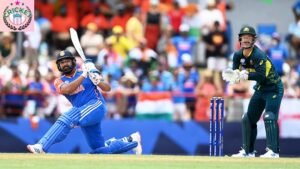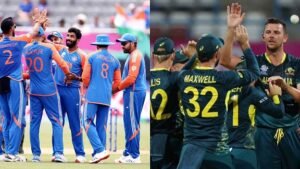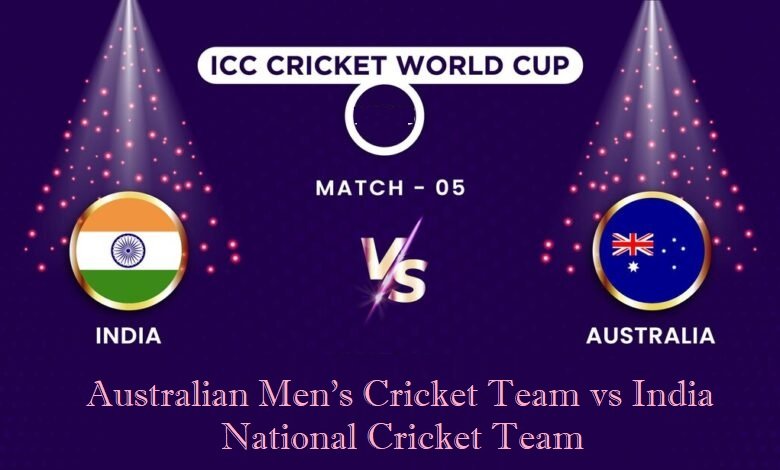Cricket is more than just a sport in Australia and India; it is a passion that unites millions of fans. Among the many exciting rivalries that have shaped the history of cricket, the clashes between the Australian Men’s Cricket Team vs India National Cricket Team stand out as some of the most fiercely contested and captivating matchups in the game. Both teams have been at the pinnacle of the sport for decades, with each nation boasting a rich cricketing history and world-class talent.
This article delves into the deep rivalry between these two cricketing giants, looking at the historical context, the most memorable encounters, key players, and the unique dynamics that make every match between Australia and India a highly anticipated event.
1. A Historical Overview of the Rivalry
The rivalry between Australia and India in cricket dates back to the early days of the sport, but it truly gained prominence in the 1990s and 2000s when both teams became dominant forces in world cricket. The initial encounters between the two teams were often one-sided, with Australia consistently emerging as the stronger side. However, over time, India began to establish itself as a cricketing powerhouse, challenging Australia both at home and abroad.
Key moments such as India’s historic series win in 2001 and the rivalry between players like Shane Warne and Sachin Tendulkar further fueled the competitive edge between the two teams. These matches have always been intense, with both sides bringing their best to the field, whether it’s in Test matches, One Day Internationals (ODIs), or T20s.
2. The Early Years: Australia Dominates
In the early stages of their rivalry, Australia dominated the cricketing scene. They were the undisputed leaders of world cricket, with a lineup featuring legends like Don Bradman, Ian Chappell, Greg Chappell, Allan Border, and Shane Warne. Their dominance was evident in the head-to-head record between the teams, with Australia regularly winning most encounters.
India, on the other hand, was still establishing itself as a cricketing nation and struggled in early contests. Despite this, India produced some remarkable individual performances during this period, with players like Kapil Dev, Mohinder Amarnath, and Sunil Gavaskar making a mark against the Australians.
3. The Turning Point: India’s Historic 2001 Series Win

The true turning point in the rivalry came in 2001, when India pulled off a historic victory in the Border-Gavaskar Trophy against Australia. The series, held in India, saw India bounce back from a heavy defeat in the first Test to win the series 2-1, thanks to brilliant individual performances from VVS Laxman (who scored a memorable 281 in Kolkata) and Rahul Dravid (who contributed a crucial 180 in the same match).
This victory marked a significant shift in the balance of power between the two teams. It was the first time India had truly challenged Australia on home soil and won a major series. The series also saw the emergence of India’s younger generation of players, including Virender Sehwag and Anil Kumble, who would go on to become integral parts of India’s cricketing success in the years to come.
4. The Era of Dominance: India Rises
Following the 2001 series win, India’s cricketing stature grew exponentially. The Indian team, under the leadership of Sourav Ganguly, became more competitive against Australia, both in Test matches and in ODIs. India’s performances abroad improved, and the team began to consistently challenge Australia in all formats of the game.
The rivalry reached new heights during the early 2000s, particularly in the one-day format. India’s aggressive batting lineup, led by Sachin Tendulkar, Virender Sehwag, and MS Dhoni, began to unsettle Australian bowlers, who had long dominated world cricket. The memorable 2003 Cricket World Cup final, where Australia defeated India, was a defining moment in the history of the rivalry. Although India lost, the match showcased India’s ability to compete with the best and laid the foundation for future encounters.
5. The 2007 ICC World Cup and the Resurgence of Australia
Despite India’s rising strength, Australia remained the dominant force in world cricket. Their resurgence in the mid-2000s, particularly with the leadership of Ricky Ponting, saw Australia continue their reign over international cricket, winning multiple ICC tournaments, including the 2007 ICC Cricket World Cup.
This period was also marked by some extraordinary individual performances from Australian players, such as Matthew Hayden, Shane Warne, Glenn McGrath, and Adam Gilchrist. However, India was never far behind, and the two teams continued to engage in tightly contested matches, particularly in the 2007 and 2011 World Cups.
6. The 2008-2010 Period: On-Field Controversies and Intense Competitions
The years between 2008 and 2010 were filled with controversy and heated exchanges both on and off the field. One of the most infamous moments in the rivalry came during the 2008 Test series in Australia, when the Indian team faced accusations of unsportsmanlike behavior and poor umpiring decisions. The incident involving Harbhajan Singh and Andrew Symonds sparked a media frenzy and highlighted the intensity of the rivalry.
Despite the tensions, the matches during this period continued to be fiercely contested. India’s triumph in the 2008 CB Series in Australia was a notable achievement and showcased their growing competitiveness in the face of Australia’s cricketing dominance.
7. India’s 2011 World Cup Victory: A Historic Achievement

In 2011, India finally reached the pinnacle of world cricket, winning the ICC Cricket World Cup on home soil. The victory was a momentous occasion, especially for the Indian team and their fans, as it marked the first time India had won the prestigious tournament since 1983.
During this time, India’s batting lineup was led by Sachin Tendulkar, Virat Kohli, and MS Dhoni, while their bowling attack was spearheaded by Zaheer Khan and Harbhajan Singh. Australia, although still a strong side, was not able to claim the 2011 World Cup, despite being one of the favorites. The tournament cemented India’s status as one of the most dominant cricketing nations in the world and strengthened the rivalry between Australia and India.
8. The 2010s: A Renewed Rivalry
With the arrival of the new generation of players, the rivalry continued into the 2010s, with India and Australia battling in several memorable series. Players like Virat Kohli, Steve Smith, David Warner, and Mitchell Starc added an exciting dimension to the rivalry.
India’s ability to perform in Australian conditions, previously seen as a challenge, was tested in 2018-19 when India won their first-ever series on Australian soil. The victory was a landmark moment for Indian cricket, signaling that India was now capable of winning in all corners of the world.
9. The Current Day: Australia vs India in 2025
As of 2025, both Australia and India continue to be powerhouses in international cricket. Australia remains a competitive force in world cricket, with players like Pat Cummins, David Warner, and Marnus Labuschagne leading the charge. Meanwhile, India, led by Rohit Sharma and Virat Kohli, continues to dominate world cricket, with a well-balanced team capable of defeating any opposition.
The rivalry between these two teams is far from over. The battles between the two cricketing titans have only become more intense, with both teams continuing to showcase their immense talent and skill.
10. Conclusion: What Makes the Rivalry So Special?
The rivalry between the Australian Men’s Cricket Team and the India National Cricket Team is one of the most iconic in the history of sport. Australia’s unrelenting drive for excellence and India’s passion for the game create a thrilling atmosphere whenever these two teams meet.
The encounters between these teams have produced some of the most memorable moments in cricket history, from dramatic Test match comebacks to heart-stopping ODI encounters. It is this blend of tradition, skill, and emotion that continues to fuel the intense rivalry between the Australian and Indian cricket teams.
As cricket fans, we are fortunate to witness this rivalry unfold, and with each new match, the legend of Australia vs India grows ever larger in the annals of cricket history.
Read More Matches: Pakistan National Cricket Team vs England Cricket Team Match Scorecard – A Comprehensive Analysis


